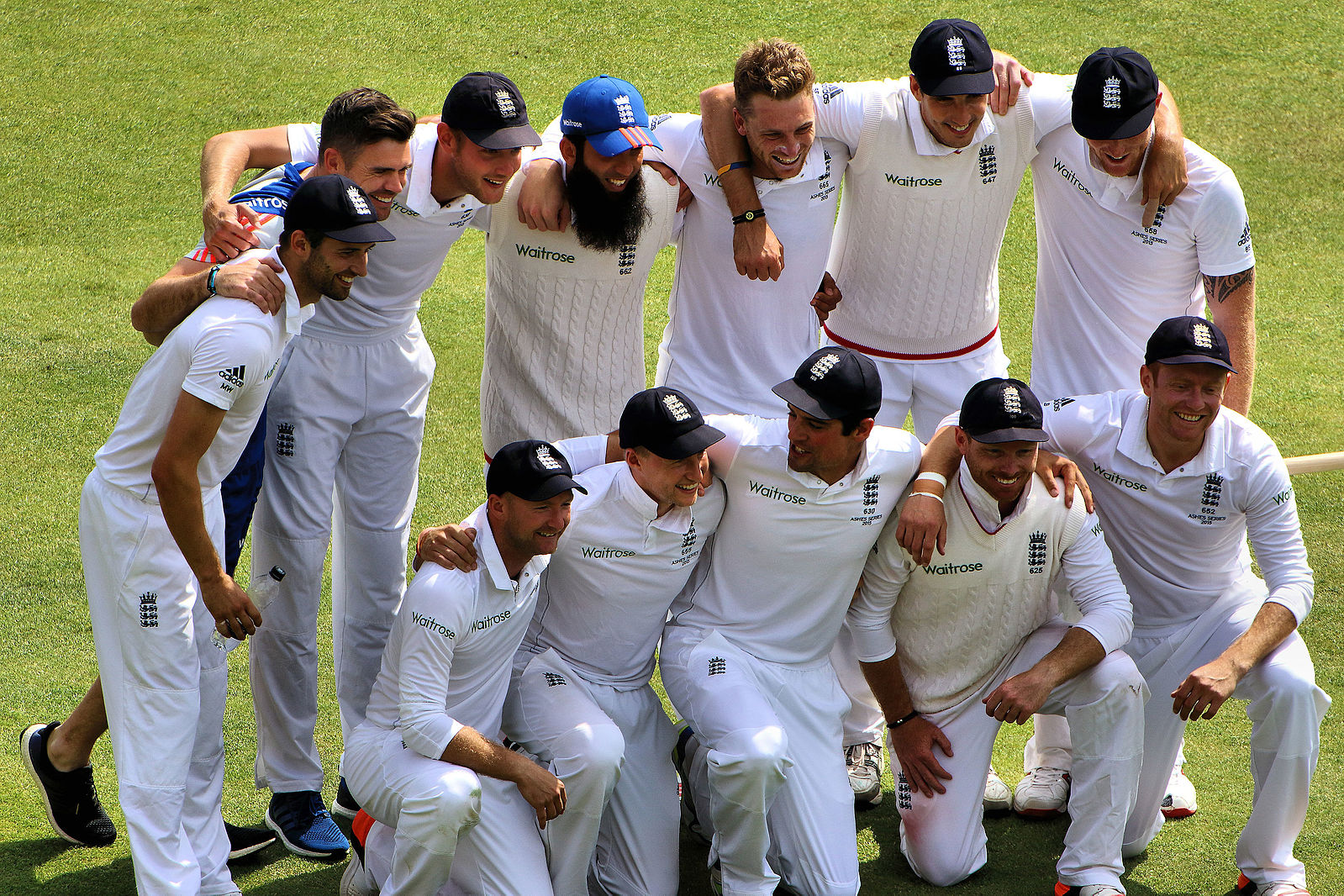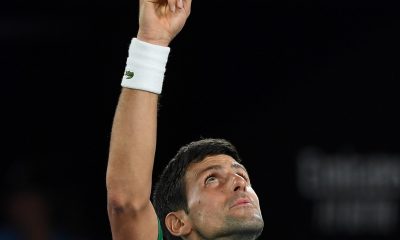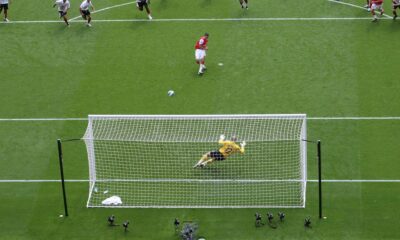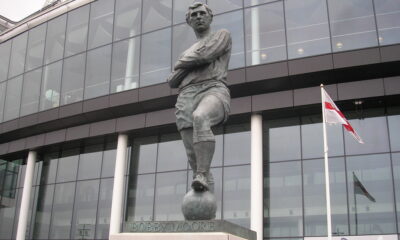Cricket
A Breakdown on the Greatest Cricket Rivalry: The Ashes

A Breakdown on the Greatest Cricket Rivalry: The Ashes
Rivalries define sport; Senna/Prost, Coe/Ovett, and Springboks/All Blacks are among the biggest rivalries in sports history. The Ashes is the rivalry that defines and transcends cricket. For over 100 years, in England and Australia, the Convicts and Poms have waged Cricketing war in one of the sport’s greatest soap operas.
With the nation engrossed in The Hundred, it feels like it is the optimum time to switch back to the long form of the game and offer a complete breakdown on an endless, eternal rivalry; The Ashes.
The Ashes Urn – What Are the Ashes?
In a nutshell, The Ashes are a little urn that contains burnt bail from the first ‘unofficial Ashes series. That urn is the prize on offer for the winning team. But, The Ashes is much more than just winning a tiny trophy. The series offers opportunities for players to become sporting legends, and it allows two nations to unite in the furnace of elite sport.
How often is the Ashes?
The series gets played every two years, alternating between venues in England and Australia.
The History
In colonial times, the land down under was a part of the British Empire. This vast land with golden soil offered plenty of prosperity to the British; instead, the empire opted to use it as a place to send some of the worst convicted criminals from the British Isles. The convicts colonial handlers would go on to found new colonies such as New South Wales and Victoria. The British aristocracy’s game of choice was Cricket. As this peculiar game began to enchant the locals, Australians opted to form their team.
A team combined with local players from Victoria and New South Wales took on a touring England team in March 1877. The locals emerged victorious over England in the first-ever test match. Five years later, England invited an Australian touring group to the UK. The Aussies won a test match at the Oval in 1882. The win prompted the Sporting Times newspaper to declare that English Cricket was dead, the remains were to get cremated, and the ashes would go to Australia. On the returning tour, England captain Ivo Bligh said that his team would regain The Ashes. The first Ashes series would take place in 1882-83.
Early English Dominance and Victor Trumper
The early series’ saw England dominate The Ashes. In the late 19th century, the English game was on top. Led by the inimitable WG Grace, England lost only four matches in the 1880s. The turn of the decade saw the Australians get back onto level terms as they would win four series’ in a row between 1892 and 1902. Aiding the Australian resurgence was the emergence of Victor Trumper. Trumper was Australian Cricket’s first golden boy. On his 1902 campaign in England, Trumper scored over 2000 runs at an average of 48.49. For The Ashes to survive in a then transient world, it needed icons. Victor Trumper was the first iconic player in Ashes Cricket.
The Don
Both nations shared the series’ before the outbreak of WW1. The post-war years yielded major success for Australia. The pace tandem of Ted McDonald and Jack Gregory powered Australia to wins against England. However, the pendulum of victory sharply swung towards England as Jack Hobbs, Herbert Sutcliffe, and Wally Hammond wrestled control.
Instead, the sporting gods provided Australia with arguably the greatest sportsperson in history; Donald George Bradman. As that trio dominated world Cricket, Australia required a once-in-a-lifetime player to re-shape the game. The Don plundered run after run, particularly in the 1930 series when Bradman scored 974 runs at an average of 139.14.
In 37 matches against England, Bradman scored over 5000 runs at an average of 89.78. It didn’t matter where and when they played; Bradman subjected England to death by a thousand runs. England had to break the rules of the game to win against Bradman’s team.
Bodyline
When England captain Douglas Jardine plotted to stop Bradman, one plan kept reverberating around his head; bodyline. Jardine instructed his fielders to stand on in the leg-side; he then told his star bowler Harold Larwood to bowl at the body of Bradman and other batsmen such as Bill Ponsford. Back then, players did not wear helmets; instead, they used their bats to protect themselves, giving fielders easy catching chances. The bodyline tactic worked as England routed Australia in a 4-1 win to regain The Ashes.
The controversial tactics caused chaos between the two sides. Australia claimed that bodyline contravened the Spirit of Cricket. The MCC agreed, and they changed the game’s rules to stop teams from packing leg-side fields. Before the series, the Ashes had always got played in a gentlemanly manner. The bodyline series gave birth to the first bit of bad blood between the two teams. Jardine was unrepentant; “I’ve not traveled 6,000 miles to make friends; I came here to win The Ashes.”
Bradman’s Invincibles
Premature retirement and a second world war seemed to have ended Bradman’s glorious career. The great Australian held other plans as he came to England for a tour in 1948. By this point, Bradman was the warhorse of a young Aussie team. Keith Miller, Sid Barnes, and Neil Harvey were some of the talented youngsters accompanying Bradman. The busy itinerary scheduled 31 games for Bradman’s team; they didn’t lose a single one. Australia won The Ashes with a 4-0 series win; the series also saw England fans break attendance records at the second, third, and fourth tests, respectively. That was due to Bradman announcing his farewell from Cricket. Everyone wished to watch the great man’s last swings of a bat. Bradman’s invincibles are regarded as one of the greatest touring teams in history. That was the end of Bradman’s Ashes career. He finished it with an almighty exclamation mark while also scratching his itch to gain revenge for bodyline.
Thommo And Lillee
The Ashes quietened down a little in the 50s and 60s; the quiet time didn’t last for too long. That was courtesy of two wild-things called Jeff Thomson and Dennis Lillee. Thommo and Lillee, as they got affectionately called, were the fastest fast bowlers of the time. Lillee would come charging in with a snarling mustache, unbuttoned shirt, and gold chain swinging from ear to ear. On the other hand, Thomson strolled in with his flock of blonde hair and swagger to bowl at 95mph. The shaggy-haired beach bum surprised England with his speed and hostility. Ian Chappell, Glenn Chappell, and Rodney Marsh joined Thomson and Lillee to form a formidable team. Australia swept aside a shocked England side. The 74/75 series created the modern DNA for Australian Cricket. The aggressive snarl, confidence bordering on arrogance, and hostility would become a feature of the Australian game, albeit with a hiatus in the 80s.
Jeff Thomson, Dennis Lillee, Max Walker and Gary Gilmour in 1975 #Cricket pic.twitter.com/3N7wcdUW1p
— Nostalgic Dave ⚽️???? (@DavidBell5667) June 7, 2021
Botham’s Ashes
That hiatus started in 1981. The ’81 Ashes series went down in history as one of the most incredible series of all time. A solid Australian squad made up of Kim Hughes, Rod Marsh, Allan Border, Rodney Hogg, Trevor Chappell, and Dennis Lillee traveled to England. They began well; Australia was 1-0 up after two matches until an inspired Ian Botham changed the series. After making an ignominious duck at Lords in the second test, Botham defied Australia in the third Test at Headingley. Australia enforced the follow-on; they held complete control until Botham slashed his way to a swashbuckling 149. Bob Willis’ scorching spell of 8/43 in the fourth innings sealed a famous England win. The momentum was with the Three Lions.
All-rounder Botham then dominated with the ball as his 5/11 gave England victory in the fourth test at Birmingham. The cavalier maverick then switched back to the bat as he pulverized Australia for another century. England’s triumph in the fifth test gave them the series win; moreover, Botham got named man of the match in three matches. The ’81 series is now known as Botham’s Ashes.
English Dominance and World Series Cricket
The defeat rocked the Australian game. And Australia then faced friendly fire from one of their own as anarchy broke out when media mogul Kerry Packer desired the TV rights. Packer, the owner of commercial-broadcaster Channel 9, wanted to buy the domestic TV contract for his station. The Australian board refused to leave their contract with ABC. An infuriated Packer opted to form his competition and host it on his channel. He enticed experienced players like Dennis Lillee, Rod Marsh, and Ian Chappell to play in the new league. The players would earn more money playing for Packer; they didn’t hesitate in joining the rebel league despite the threat of international exile.
As Packer’s World Series Cricket embraced innovative TV coverage, coloured kits, and day/night play, Australian Cricket got stuck in the doldrums. More and more players defected from the international team to ply their trade in Packer’s circus. The split led to the significant decline of the Australian national team.
England’s star-studded outfit of Botham, Mike Brearley, David Gower, and Graham Gooch was too strong for an inexperienced, outmatched Australian team. Between 1981 and 1988, England would win every Ashes series. Ashes series became a source of humiliation for Australians; their national team was in ruins. At an Australian Davis Cup Tennis game, the PM congratulated the Tennis team while disparaging the Cricket side. Australia was at its lowest moment.
Captain Grumpy
Australian Cricket required a new hero, a totemic saviour, to reclaim The Ashes. Instead, they got a reluctant captain who was friendlier with the England players than his teammates. After Kim Hughes’ tearful resignation, Allan Border took the reins. AB captained Australia on their tour of England in 1989. Border shared a friendly relationship with his counterpart David Gower; it was something that the Australian media used to criticise Border. Border knew this, and he changed his attitude to the English in the 1989 series. Gower got taken aback by Border’s hostility; the Australian team gravitated towards it.
Young players such as Steve Waugh, Mark Taylor got inspired by Border’s never-say-die batting, bristling confidence, and ruthless desire to win. The Australian’s emphatically routed England in a 4-0 win. The triumph heralded a change in fortunes for the men in Baggy Green. Allan Border re-taught Australia the DNA of their Cricket. The reluctant captain ascended into Australia’s leader. Border and 1989 spawned an era of domination never seen before in international Cricket.
The captain who turned ??'s fortunes around!
At the time of his retirement, he held the record for most Tests (156), Test runs (11,174), Test catches (156), consecutive Tests (153) and Tests as captain (93) ? #OnThisDay Allan Border turns 66 ? https://t.co/yJ4o6bWzQO pic.twitter.com/RQY6O4nY00
— ESPNcricinfo (@ESPNcricinfo) July 27, 2021
The Greatest Team Ever
After Australia regained The Ashes in 1989, they would dominate England and the rest of the world. Led by Border in 91 and 93, Australia outplayed England. The emergence of lynchpin players like Shane Warne, Mark Waugh, Steve Waugh, and Glenn McGrath helped Australia crush the opposition. Wins in all Cricketing frontiers got achieved by the Australians in the test match arena. The Australians would also win two 50-over World Cups in 1999 and 2003. From 1989 to 2004, Australia held a vice-like grip on The Ashes. The depth, the generational players, and a burning desire to rewrite the record books drove the Australian side to unprecedented levels of success.
To underline Australia’s dominance over England, from 1989 to 2002-03, England won a paltry seven matches out of 44 against the Australians. Border handed the captaincy over to Mark Taylor; the team got even better. After Taylor retired, Waugh’s stewardship saw them dismantle England every 18 months. Everywhere one looked at an Australian lineup, Hall of Fame players filled their 11. The ’90s and early 2000s belonged to Australia. England had become the little piece of chewing gum on Australia’s Green and Gold-clad boot as they marched towards global domination. English Cricket needed something special.
2005
England found something special in the sweltering summer of 2005. Michael Vaughan was now captaining his first Ashes series, as was rival Ricky Ponting for Australia. The Australians started convincingly at Lords as Glenn McGrath tore through the English batters. A young Kevin Pietersen battled in vain; nevertheless, he did show some promise in that first game.
The 2005 series changed entirely in the warm-up before the second test at Birmingham. Australia’s prolific fast-bowler Glenn McGrath trod on a stray ball and injured his ankle. McGrath got ruled out. With England’s four-pronged attack of Matthew Hoggard, Steve Harmison, Simon Jones, and Freddie Flintoff, the series took on a different complexion.
With Australia now McGrath-less, the English batters tore into the Aussie attack after captain Ricky Ponting won the toss and sent England into bat. England bludgeoned 407 in their first innings; Australia could only respond with 308. It looked like the game was England’s to lose until spin king Shane Warne weaved another tapestry of brilliance in the third inning. The genius took 6/43 to bowl England out cheaply. Australia chase was a rollercoaster of emotions as the Aussie lower order defied a charging Freddie Flintoff to stay in the game.
It came down to the last over where England needed to take one wicket, and Australia required a handful of runs. On the third-last ball, Steve Harmison hit the glove of Michael Kasprowicz, and he got caught down the leg side. England had won a dramatic test, maybe the best test ever, and the 2005 series was alive and kicking.
Emotional England Ride the Wave
After the narrowest of wins in Birmingham, Australia hung onto a draw at Old Trafford. Captain Ricky Ponting toughed it out for a gritty century to hold England off. The wild celebrations on the Australian balcony signaled to Michael Vaughan that this Australian team was beatable. By this point, The Ashes had gripped an entire nation. The benefit of terrestrial TV coverage stopped a country. The fourth test at Trent Bridge featured another flashpoint as sub fieldsman Gary Pratt ran out Ricky Ponting. The Australian captain ripped into England head coach Duncan Fletcher; England had rattled the Australians.
A daring fourth innings chase later, England got home and hosed courtesy of Ashley Giles. They now held a 2-1 lead going into the final test. Australia was in the hunt on the last day until the arrival of a superstar had them at bay. Kevin Pietersen’s thrilling 150 finished the game. The umpires declared the game a draw, and England regained The Ashes for the first time since 1989. An audience of around eight million tuned in on that Monday tea-time to witness history.
We Need to Talk About Shane
After Sir Donald Bradman, Shane Keith Warne is arguably the greatest Cricketer in Ashes history. The spin wizard took over 700 test match wickets; he claimed 195 English wickets in 37 Ashes matches. From 1993 to 2007, Warne bamboozled and humbled his opponents. He played ringmaster at this circus, and the English batsmen became his clowns. The Gatting Ball, the Strauss Ball, and the celebrations all got etched into sporting folklore.
Perhaps Warne’s most significant achievement came in the 2006-07 series. After surrendering the urn in 2005, Ricky Ponting’s Australian team approached the 06-07 series in mean form. This team of legends got hurt, humbled, and pilloried by their home media and fans. From the offset, Australia dismembered England. As England arrived onto Australian shores, Ponting, Warne, and company were in no mood to experience that again. No one relished it more than Warne.
Amazing Adelaide
The second test at the beautiful Adelaide Oval proved to be Warne’s theatre. After England won the toss and piled on the runs, Australia looked locked in a vulnerable position. They toiled in their first innings as they got close to England’s total. Both first innings had only got completed by day four, a meaningless draw beckoned. Except Warne had other ideas; he sensed England would play for the tie, and he attacked. With his captain Ponting by his side, Warne spun one more magical spell to destroy England.
The Australians chased down England’s miserly total on an epic day of test match play. The second test got renamed Amazing Adelaide; it became Shane Warne’s kingdom for a day. The fifth-day performance from the then 37-year-old Warne was probably his most extraordinary spell of bowling in The Ashes. After a gut-wrenching defeat in Adelaide, England could not come back. They lost the urn in a 5-0 series defeat, while Warne got a fairytale finish to his international career.
11,491 Test runs and 1,271 wickets between them ?#OnThisDay in 2007, @ShaneWarne, @glennmcgrath11 and Justin Langer bowed out from Test cricket after Australia sealed a 5-0 Ashes whitewash. pic.twitter.com/2X2iUc94TJ
— ESPNcricinfo (@ESPNcricinfo) January 5, 2021
English Superiority
The 2009 series birthed a short era of English superiority. After Monty Panesar and Jimmy Anderson’s remarkable tenth wicket stand at Cardiff, England comfortably outplayed Australia at Lords. Freddie Flintoff channeled his magic one last time before retiring with a final day five-for to win the game. Australia did hit back at Headingley, but Stuart Broad’s inspired spell at The Oval. England regained The Ashes in 2009. It was a massive fillip for new captain Andrew Strauss.
England followed up that 2009 success by humbling the Aussies on home soil 2010-11. A 3-1 victory helped England win in Australia for the first time in over two decades. Despite Strauss’ retirement, England ticked on in the 2013 Ashes series. But it was no average year; after the summer series, another series awaited in Australia in November 2013. An Australian team in disarray came to England, courted controversy, and went home on the wrong end of a 3-0 defeat. And a ferocious moustache wanted its revenge.
Menacing Mitch
In November 2013, England landed in Australia as the overwhelming favourites. Sir Ian Botham, now commentating for Sky, even predicted a 5-0 win for England. Instead, former Barmy Army figure of fun Mitchell Johnson ripped up every script and blew away England with some sizzling fast bowling.
He grabbed his redemption in the 13-14 series by emphatically ending England’s hold on The Ashes. Johnson was hostile, nasty, and displayed searing speed. Johnson terrorized England’s batsmen physically and mentally after hitting rock bottom in the 2010-11 series. The bowler once dubbed by Dennis Lillee as a once-in-a-lifetime talent looked broken physically and mentally.
He took 37 wickets to turbocharge a 5-0 win for Australia. That tour ended Jonathan Trott, Michael Carberry, Tim Bresnan, Chris Tremlett, Scott Borthwick, Boyd Rankin, and Kevin Pietersen’s England careers. The 13-14 Ashes should get renamed the Mitchell Johnson Ashes. Bowling at 90mph plus, he thrilled fans and teammates with express fast bowling. He was unplayable.
?? Happy birthday, Mitchell Johnson ?
? 37 wickets @ 13.97 in the 2013/14 Ashes ?
Utterly devastating ?pic.twitter.com/hHnG0oqoKo
— The Cricketer (@TheCricketerMag) November 1, 2020
The Baby Don?
England regained The Ashes in the 2015 series; they triumphed 3-2 in Alastair Cook’s final stand as an Ashes England captain. The 17/18 series got controlled by a new captain. Australia’s ugly duckling Steven Smith ground England into the dirt. In seven innings, Smith scored 687 runs at an average of 137.40.
Who won the Ashes 2019?
After sandpaper-gate and serving a suspension, Smith returned to Ashes Cricket in England during the 2019 series. The boo’s made the test grounds inaudible every time Smith walked out into the middle. The crowd was ripping into him. Many members of the Cricketing punditocracy felt it would hinder Smith. Short story, it didn’t. Smith blocked out the boos of Edgbaston as he scored hundreds in both innings. He was on his way to another century until he got hit by Jofra Archer.
Smith missed England’s miracle win at Headingley due to concussion. He returned, once again, everyone questioned him. He answered the questions in stunning style. Smith fidgeted and shuffled his way to 211, which set up Australia to win the game, and they retained The Ashes. Smith scored 774 games in just four runs. He showed how great he was. Statistically, Smith is the greatest test batsman post-Bradman.
When is the next Ashes?
With Australia’s strict Covid measures, the 2021-22 Ashes series will go ahead. The venues, as usual, are the Gabba in Brisbane, the day/night Test at Adelaide, Perth’s Optus Stadium will host test three before Christmas and New Year’s get celebrated at the MCG and SCG.
Australia will come into the series as favourites. Their pace attack led by Pat Cummins, Mitchell Starc, and Josh Hazlewood is elite. Add that to the batting of Steve Smith and Marnus Labuschagne, and the Australians are a formidable outfit.
England must hope that the injury-prone Jofra Archer, Olly Stone, and Mark Wood are healthy come November. It is a challenging task; there is a mountain of Cricket on England’s schedule before they head down. Those three are vital because they are fast bowlers. In the hot, sunny, dry Australian conditions, the ball doesn’t swing much. Therefore, Jimmy Anderson and Stuart Broad are often negated. England’s record in the 21st century in Australia is miserable; they’ve played 25, they’ve lost 19.
The Ashes is the ultimate crucible for players; for England players, they must pull off a miracle if they are to return with the urn. For Australia, only a series win will do. The pressure is always on head coach Justin Langer; retaining the urn will placate the constant scrutiny. It will be dramatic, loud, hostile, and fiery. That is Ashes Cricket at its best.
SWe hope you enjoyed the article ‘A Breakdown on the Greatest Cricket Rivalry: The Ashes.’ What is your favourite memory from the Ashes? let us know!
Read more new on cricket below:
-

 News1 month ago
News1 month agoThe Best Male Tennis Players of All Time
-

 Uncategorised1 month ago
Uncategorised1 month agoWhat Dinosaur Has 500 Teeth?
-

 News1 month ago
News1 month agoThe Fastest Rugby Players Ever
-

 Football1 month ago
Football1 month agoThe Best Penalty Takers of All Time
-

 Football1 month ago
Football1 month ago10 of the most underrated footballers in the world right now
-

 Football1 month ago
Football1 month agoPlayers with the most goals in a Premier League season
-

 Football1 month ago
Football1 month agoWho is the Fastest Football Player in the World?
-

 Football1 month ago
Football1 month agoChelsea’s Possible Lineup For Next Season



















